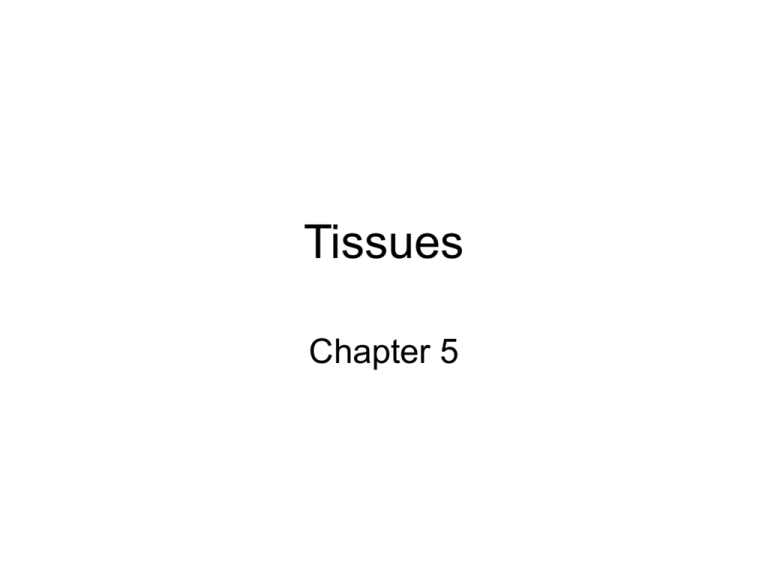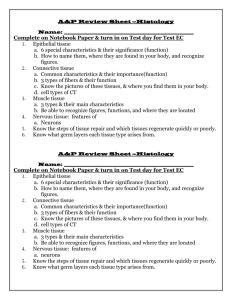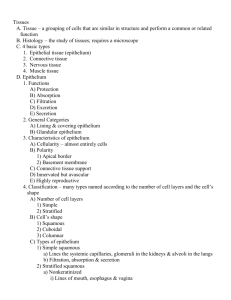Tissues - Educypedia
advertisement

Tissues Chapter 5 Tissues • A tissue is a group of similar cells that usually have a similar embryological origin and are specialized for a particular function. • Tissue cells are often separated by nonliving, intercellular materials that cells produce. This substance is called the matrix. • Histology – the study of tissues Four Principal Types of Tissues: • Epithelial –covering and lining; and glands • Connective – protects and supports, binds organs together, stores energy, and provides immunity • Muscle – movement • Nervous –transmits impulses that coordinate body activities Feature of Epithelial Tissue • Closely packed cells with little extracellular material • Epithelial cells are arranged in continuous sheets, in single or multiple layers • Epithelial cells have an apical (free) surface, which is exposed to body cavity, lining of internal organ or exterior of body, and a basal surface which is attached to a basement membrane • Cell junctions are plentiful, providing secure attachments among cells. • Epithelia are avascular, blood vessels are located in nearby connective tissue; exchange of materials occurs by diffusion. • Epithelia adhere firmly to nearby connective tissue by means of the basement membrane . • Epithelia have a nerve supply. • Epithelia have a high capacity for renewal (high mitotic rate) since it is subjected to wear and tear. • Epithelial functions include: protection, filtration, lubrication, secretion, digestion, absorption, excretion, transportation, sensory reception, and reproduction. Covering and Lining Epithelium Epithelial layers are arranged as: • simple epithelium -(one layer), where diffusion, osmosis, filtration, secretion and absorption occur. • stratified epithelium (several layers), protects underlying tissue from wear • pseudostratified epithelium (one layer that appears as several) because nuclei at different level; not all cells reach the surface; those that do have cilia or secrete mucus. Cell Shapes • squamous (flat) for diffusion • cuboidal (cubelike) - produce secretions and function in absorption • columnar (rectangular) - protect underlying tissue, may have cilia, secretion or absorption. • transitional (variable) - change in shape from flat to columnar due to distention, expansion or movement of body parts. Classification is by number of layers and cell shape (top layer) • Simple squamous epithelium consists of a single layer of flat cells. It is adapted for diffusion, osmosis and filtration and is found in lungs and kidneys. Endothelium lines the heart, blood vessels, and lymph vessels and forms the walls of capillaries. • Simple cuboidal epithelium consists of a single layer of cube-shaped cells. It is adapted for secretion and absorption. Simple columnar epithelium comes in two forms: Nonciliated simple columnar epithelium a single layer of nonciliated rectangular cells. Also functions in secretion and absorption. Specialized cells containing microvilli perform absorption. Goblet cells secrete mucus Ciliated simple columnar epithelium consists of a single layer of ciliated rectangular cells. Aids in movement. • Pseudostratified columnar epithelium has only one layer but gives the appearance of many. All cells are anchored to the basement membrane, but some do not reach the surface. • 1) Psuedostratified ciliated - has cilia and goblet cells Functions in secretion and movement. • 2) Pseudostratified nonciliated has no cilia or goblet cells. Stratified Epithelial Tissue - at least two layers of cells. Named by shape of the cells in the superficial layer. Stratified squamous epithelium – several layers of cells in which the top layer is flat, bottom layers vary from cuboidal to columnar. Its function is protection (against abrasion). Basal layers continually replicate. a) Nonkeratinized variety lines the mouth, vagina and anus; remains moist b) Keratinized variety forms contains protein keratin - outer layer of skin. waterproof, resistant to friction, helps repel bacteria. 2) Stratified cuboidal epithelium consists of several layers of cells in which the top layer is cube-shaped. Fairly rare. Function is mainly protective. 3) Stratified columnar epithelium consists of several layers of cells in which the top layer is rectangular. Also uncommon. Usually basal layers are shortened, irregular polyhedral cells. It protects and secretes. 4) Transitional epithelium consists of several layers of cells whose appearance is variable, whether stretched or relaxed. It lines the urinary bladder, and parts of the ureters and urethra. It is capable of stretching. Tight junctions in theses areas prevent leaks and diffusion. Glandular Epithelium • A gland is a single cell or a mass of epithelial cells adapted for secretion. • There are two types depending on how the cells release the substances they produce: Exocrine glands and endocrine glands •1) Exocrine glands secrete into ducts or directly onto a free surface. Their secretions include mucus, sweat, oil, ear wax and digestive enzymes. Structural classification of exocrine glands : multicellular glands - most glands, have a distinctive appearance. Communicates with the surface unicellular glands - single celled. goblet cells. No ducts. Functional classification of glands : Holocrine - accumulate secretions in cell, cell dies, and is discharged with its contents as a glandular secretion. The discharged cell is replaced by a new cell. ex. sebaceous or oil gland in skin Merocrine - most exocrine glands, form secretion and discharge by exocytosis. Apocrine glands - secretions accumulate near the top, which pinches off to form secretion. Cell repairs itself and repeats. ex. mammary glands. Endocrine glands - called “ductless glands” discharge their secretions into the intracellular fluid, where it diffuses into the blood stream. These secretions are hormones, or chemical messengers, which regulate many bodily functions. Connective Tissue • Connective tissue is the most abundant and widely distributed tissue in the body . • All connective tissues have the same embryonic origin- from mesodermal cells called mesenchyme. The functions of connective tissue: 1. Binding, attachment and support (bones, tendons and ligaments, organs) 2. Protection- bones and adipose tissue 3. Insulation - adipose tissue 4. Storage - of energy and fat soluble substances 5. Transportation - blood General Features of C.T. 1) It consists of three basic elements : cells ground substance fibers Extracellular Called the matrix Noncellular 2) Does not occur on free surfaces such as linings, except for the joint cavities which are lined by areolar connective tissue. 3) Except for cartilage, it has a nerve supply. 4) Usually highly vascular, except for cartilage (avascular) and tendons which have a small blood supply. 5) Matrix may be fluid, semifluid, gelatinous, fibrous, or calcified. It is usually secreted by the connective tissue cells (except for blood) and adjacent cells, and determines the qualities of the tissue. (hard, rubbery, fluid, etc.) 6) Cells can usually divide Cells of Connective Tissue: Immature cell names end in - blast. These cells can reproduce and form the matrix Mature cell names end in -cyte. These cells have a reduced ability to divide and form matrix. Fixed cells - appear in tissues in stable numbers Wandering cells - found in tissues only in response to infection or injury Fibroblasts - most common type of fixed cell. They secrete the matrix; particularly the fibers of the matrix. Macrophages develop from monocytes. Phagocytize bacteria or cell debris. Wandering macrophages leave the blood and wander to infected tissues , while fixed macrophages remain in certain tissues and organs. Important in infection and immunity. Mast cells are found along blood vessels and produce histamine, which dilates small blood vessels during inflammation. They contain heparin, an anticoagulant. Also involved in allergic responses. Cells specific to a particular type of connective tissue: Adipocytes - store triglycerides. Insulate and cushion Osteocytes (osteoblasts) - bone Chondrocytes (chondroblasts) cartilage leukocytes and erythrocytes ( hemocytoblast)- blood Fibers: Collagen fibers made of collagen. Collagen fibers are tough and only slightly elastic.. They often occur in bundles with the fibers parallel to one another, which gives great tensile strength. Collagen is found in most connective tissues, esp. bone, tendons, and ligaments. Elastic fibers are composed of a protein called elastin and glycoprotein framework. They are very stretchy and branch and join to form a network. They provide strength to tissues, but allows the tissue to be flexible and stretchy. They are found in skin, blood vessels, and lungs Reticular fibers are composed of collagen and glycoprotein. They provide support and form loose networks of fibrous tissue. They are found around fat cells, nerve fibers, and skeletal and smooth muscle cells. They also form the stroma or supporting framework of many soft, nonmuscular organs such as the spleen and lymph nodes. These fibers also help form the basement membrane. Ground substance can contain a variety of large molecules. Some are which are complex combinations of polysaccharides and proteins. Some of these are hylauronic acid , chondroitin sulfate, and keratan sulfate. Other molecules in the matrix are adhesion proteins. Adhesion proteins anchor cells in position and to provide traction for movement of cells. The ground substance supports and binds cells together, and provides a medium for the exchange of materials. Types of Connective Tissues: Connective Tissue Proper: Loose Connective Tissue or Areolar connective Tissue - It is loosely arranged, it is found wrapping organs and under skin, and holds and conveys tissue fluid. Contains primarily fibroblasts, but also macrophages, adipocytes and some blood cells. It contains all three fiber types, randomly arranged. The ground substance is fluid, semifluid or gelatinous. This tissue contains hyaluronic acid, which is thick and may slow the passage of some drugs. Hylauronidase is an enzyme produced by wbc’s, sperm and some bacteria. Injection of hyaluronidase can speed the passage of drugs and fluid through the tissue. adipose tissue- cells are adipocytes, and specialize in storing fat. Adipocytes are tightly packed, and very little matrix . They accumulate under the skin and yellow marrow of long bones. Functions in energy reserves, insulation, protection, and support. reticular connective tissue - consists of reticular fibers and fibroblasts and forms the supporting framework for cells in the liver, spleen, lymph nodes and bone marrow. Dense connective tissue has fibers as the dominant component. Dense regular connective tissuecollagen fibers are arranged in parallel bundles which makes this tissue flexible, but resistant to stretching. Fibroblasts are found in rows between the fibers. Found in tendons and ligaments. Blood supply is poor. Dense irregular connective tissue - also has collagen fibers and fibroblasts, but the collagen fibers are thicker and arranged irregularly. (Like felt material) This tissue usually forms sheets, and resists pulling in many directions. It is found in heart valves, around cartilage, bone, muscles, dermis of skin, and around some organs. Elastic connective tissue consists of elastic fibers and fibroblasts. Very elastic. It is found in the lungs, walls of arteries, bronchial tubes and in the attachments between the vertebrae. Specialized Connective Tissues: Cartilage has a dense network of collagen fibers, which gives strength, and elastic fibers. The matrix contains chondroitin sulfate, which is rubbery and gives cartilage resilience. Cells are chondrocytes, and are found in lacuanae. Surface of cartilage is surrounded by perichondrium, where blood vessels are located. No blood supply in the cartilage itself. Hyaline cartilage - (gristle) most abundant cartilage, and weakest. It has very fine collagen fibers and a resiliant gel as its ground substance. It is found in the embryonic skeleton, at the ends of bones , in the nose, and in respiratory structures. It is flexible, allows movement, reduces friction, absorbs shock and provides support. Important in bone growth and repair. Elastic cartilage - has condrocytes in a network of elastic fibers. It maintains the shape of organs such as the epiglottis of the larynx, auditory (Eustachian) tubes, and external ear. Fibrocartilage contains visible bundles of collagen fibers and combines strength and rigidity. Also acts as a shock absorber. It is found in the pubic symphysis, intervertebral discs, and menisci (cartilage pads) in joints. It is the strongest cartilage. Bone (osseous tissue) consists of collagen fibers (flexibility) , mineral salts (that contribute to the hardness of bone) and cells called osteocytes. It is covered by the periosteum and lined by the endosteum. It can be compact or spongy depending on how the matrix and the cells are organized. The basic unit of compact bone is the osteon or Haversian system. It supports, protects, helps provide movement, stores minerals, and houses blood-forming tissue. Blood (vascular tissue) consists of plasma and formed elements (erythrocytes, leukocytes, and platelets). Functionally, its cells transport oxygen and carbon dioxide, carry on phagocytosis, participate in allergic reactions, provide immunity, and bring about blood clotting. Muscle Tissue Skeletal voluntary cells are long many nuclei striated Smooth involuntary short, spindle-shaped single nucleus nonstriated Cardiac involuntary branched single nucleus striated intercalated disks Nervous tissue neurons : Dendrites - (one or many) receive incoming signals Cell body Axon - (one) transmits outgoing signals neuroglia : protective and supporting cells








